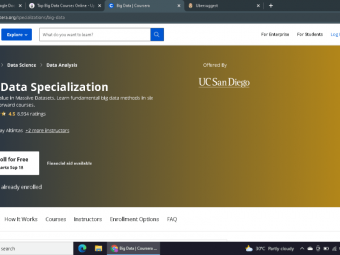Machine Learning With Javascript
Tags: Machine Learning
Master Machine Learning from scratch using Javascript and TensorflowJS with hands-on projects.
Last updated 2022-01-10 | 4.6
- Assemble machine learning algorithms from scratch!- Build interesting applications using Javascript and ML techniques
- Understand how ML works without relying on mysterious libraries
What you'll learn
* Requirements
* Basic understanding of terminal and command line usage* Ability to read basic math equations
Description
If you're here, you already know the truth: Machine Learning is the future of everything.
In the coming years, there won't be a single industry in the world untouched by Machine Learning. A transformative force, you can either choose to understand it now, or lose out on a wave of incredible change. You probably already use apps many times each day that rely upon Machine Learning techniques. So why stay in the dark any longer?
There are many courses on Machine Learning already available. I built this course to be the best introduction to the topic. No subject is left untouched, and we never leave any area in the dark. If you take this course, you will be prepared to enter and understand any sub-discipline in the world of Machine Learning.
A common question - Why Javascript? I thought ML was all about Python and R?
The answer is simple - ML with Javascript is just plain easier to learn than with Python. Although it is immensely popular, Python is an 'expressive' language, which is a code-word that means 'a confusing language'. A single line of Python can contain a tremendous amount of functionality; this is great when you understand the language and the subject matter, but not so much when you're trying to learn a brand new topic.
Besides Javascript making ML easier to understand, it also opens new horizons for apps that you can build. Rather than being limited to deploying Python code on the server for running your ML code, you can build single-page apps, or even browser extensions that run interesting algorithms, which can give you the possibility of developing a completely novel use case!
Does this course focus on algorithms, or math, or Tensorflow, or what?!?!
Let's be honest - the vast majority of ML courses available online dance around the confusing topics. They encourage you to use pre-build algorithms and functions that do all the heavy lifting for you. Although this can lead you to quick successes, in the end it will hamper your ability to understand ML. You can only understand how to apply ML techniques if you understand the underlying algorithms.
That's the goal of this course - I want you to understand the exact math and programming techniques that are used in the most common ML algorithms. Once you have this knowledge, you can easily pick up new algorithms on the fly, and build far more interesting projects and applications than other engineers who only understand how to hand data to a magic library.
Don't have a background in math? That's OK! I take special care to make sure that no lecture gets too far into 'mathy' topics without giving a proper introduction to what is going on.
A short list of what you will learn:
Advanced memory profiling to enhance the performance of your algorithms
Build apps powered by the powerful Tensorflow JS library
Develop programs that work either in the browser or with Node JS
Write clean, easy to understand ML code, no one-name variables or confusing functions
Pick up the basics of Linear Algebra so you can dramatically speed up your code with matrix-based operations. (Don't worry, I'll make the math easy!)
Comprehend how to twist common algorithms to fit your unique use cases
Plot the results of your analysis using a custom-build graphing library
Learn performance-enhancing strategies that can be applied to any type of Javascript code
Data loading techniques, both in the browser and Node JS environments
Who this course is for:
- Javascript developers interested in Machine Learning
Course content
15 sections • 189 lectures








 This course includes:
This course includes:








![MERN Stack E-Commerce Mobile App with React Native [2021]](https://img-c.udemycdn.com/course/100x100/3655146_832c_3.jpg)







